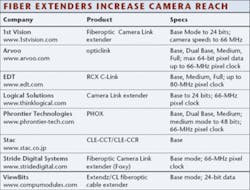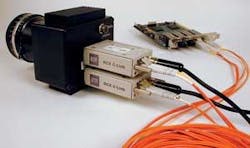Camera-extender market heats up
By Andrew Wilson
If there is one thing certain about the telecommunications market, it is that, of late, it has not seen the rapid growth that it experienced in the past. However, the advances that have been made in deploying low-cost high-speed networks have benefited other areas, noticeably machine vision. Developers looking to extend the distances between their cameras and host computers in high-EMF or hazardous environments have benefited most from telecom advances.
After endorsing the Automated Imaging Association (AIA; Ann Arbor, MI, USA; www.machinevisiononline.org) Camera Link standard a number of years ago, many system developers realized they would need to increase the limited 10-m camera-to-frame-grabber cable lengths of these products. Third-party fiberoptic extenders were soon introduced to meet these demands (see table), and they have worked well for Base- and Medium-mode cameras. Full-mode cameras, however, presented a challenge because it has been difficult to meet the 85-MHz/64-bit rate. Solutions have mostly been complicated, requiring multiple extenders pieced together for extra bandwidth.
“Indeed, the transceivers themselves have been the bottleneck to advances in bandwidth, and most companies use standard, off-the-shelf transceivers that result in a two-way communication data rate of 2.5 Gbits/s over a dual-fiber combination,” says Jerry Gaffke, senior hardware engineer at Engineering Design Team (EDT; Beaverton, OR, USA; www.edt.com). His company’s Full-mode Camera Link solution required one of the company’s matchbox-sized RCX C-Link modules for Base mode, two modules for Medium mode, and three modules for Full mode (see photo). Now, EDT has announced a new Full-mode solution that uses two RCX C-Link modules for Full-mode cameras.
Medium-mode Camera Link camera uses two EDT RCX C-Link modules to communicate with an EDT PCI DV FOX fiberoptic frame grabber.
“Using a new type of transceiver-one that still uses LC duplex cables for Base- and Medium-mode cameras-we can assign three fibers to transmit camera data to the frame grabber at 2.5 Gbaud. The remaining fiber transmits data from the frame grabber to the camera for camera control. There are still limitations to Full-mode capability at the frame grabber, but EDT will soon offer a PCI Express fiberoptic frame grabber that will solve this problem,” says Gaffke.
Lower-data-rate cameras already using non-Camera Link serial interface standards have other options, because serial buses such as FireWire, USB 2.0, and Gigabit Ethernet fiber repeaters do not require multiple fiber pairs as does Camera Link. When compared with Camera Link, these serial data rates are slow, and all can be met by single duplex transceiver products. Both Ophit (Anaheim, CA, USA; www.ophitusa.com) and Newnex Technology (Sunnyvale, CA, USA; www.newnex.com) offer FireWire-to-fiber converters, while companies such as MRV Communications (Chatsworth, CA, USA; www.mrv.com) and Optovalley (distributed by Computer Modules; San Diego, CA, USA; www.compumodules.com) allow Gigabit Ethernet-based cameras to transmit data over long-haul fiber.
Interestingly, the trend toward developing cameras based on serial interfaces has led to the adoption of converters built not by OEMs in the traditional machine vision industry. Rather, companies with established telecommunication products are gaining strength in the imaging market, especially since 2.5-Gbit/s fibers have recently become economical. And, as the trend toward adopting such serial buses increases, it is likely that more companies will see the machine-vision market as a new opportunity.


